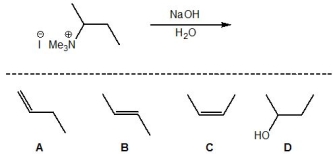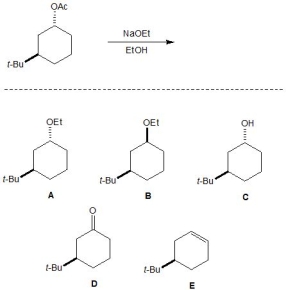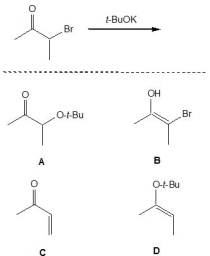A) This is an SN2 reaction which is accelerated in non-polar solvent.
B) This is an SN2 reaction which is accelerated in polar solvent.
C) This is an SN1 reaction which is accelerated in non-polar solvent.
D) This is an SN1 reaction which is accelerated in polar solvent.
F) B) and D)
Correct Answer

verified
Correct Answer
verified
Multiple Choice
Which of the following alkyl halides has the fastest rate for a SN1 reaction?

A) A
B) B
C) C
D) D
E) All of the above have the same rate of reaction
G) C) and E)
Correct Answer

verified
Correct Answer
verified
Multiple Choice
For the following SN2 reaction, what would be the relative rate of reaction if the concentrations of the alkyl bromide and potassium acetate (CH3CO2K) were tripled?

A) No change in the relative rate
B) The relative rate will increase by three times
C) The relative rate will increase by six times
D) The relative rate will increase by nine times
F) C) and D)
Correct Answer

verified
Correct Answer
verified
Multiple Choice
Match the chemical descriptors to the following molecules:
 -Weak electrophile
-Weak electrophile
A) C
B) A
C) D
D) B
F) B) and D)
Correct Answer

verified
Correct Answer
verified
Multiple Choice
What is the major product of the following reaction?

A) A
B) B
C) C
D) D
F) A) and D)
Correct Answer

verified
Correct Answer
verified
Multiple Choice
Match the chemical descriptors to the species in the following reaction:
 -K+
-K+
A) Nucleophile
B) Leaving group
C) Electrophile
D) Counter ion
F) None of the above
Correct Answer

verified
Correct Answer
verified
Multiple Choice
Match the chemical descriptors to the species in the following reaction:
 -CH3OTs
-CH3OTs
A) Nucleophile
B) Leaving group
C) Electrophile
D) Counter ion
F) C) and D)
Correct Answer

verified
Correct Answer
verified
Multiple Choice
Which is the major product of the following reaction?

A) A
B) B
C) C
D) D
E) E
G) B) and E)
Correct Answer

verified
Correct Answer
verified
Multiple Choice
Match the chemical descriptors to the species in the following reaction:
 --SAc
--SAc
A) Nucleophile
B) Leaving group
C) Electrophile
D) Counter ion
F) None of the above
Correct Answer

verified
Correct Answer
verified
Multiple Choice
Identify the final products and by-products of the following activation reaction. Please select all that apply.

A) H3C-Cl
B) H3C-SO2Cl
C) Cl-
D) SO2
F) None of the above
Correct Answer

verified
Correct Answer
verified
Multiple Choice
For the following reaction, pick out the major product:

A) A
B) B
C) C
D) D
F) A) and D)
Correct Answer

verified
Correct Answer
verified
Showing 21 - 31 of 31
Related Exams